Introduction
- The proposed project is intended to explore the prevention of infections and complications associated with Foley catheter use in surgical patients.
- This presentation provides a description of the change strategies that will be used to ensure the success of the proposed practice intervention.
- This is line with the observation made by Melnyk and Fine-Overholt (2015) that underscores the need for nursing professionals to use change strategies and change theories to inform evidence-based practice (EBP).
- It is believed that this presentation will provide deep insights on how the proposed practice change will be implemented using the described theories and Lean principles.
- It is important to note that the proposed project was conceptualized against a backdrop of increasing number of surgical patients who develop infections and complications upon exposure to catheterization.
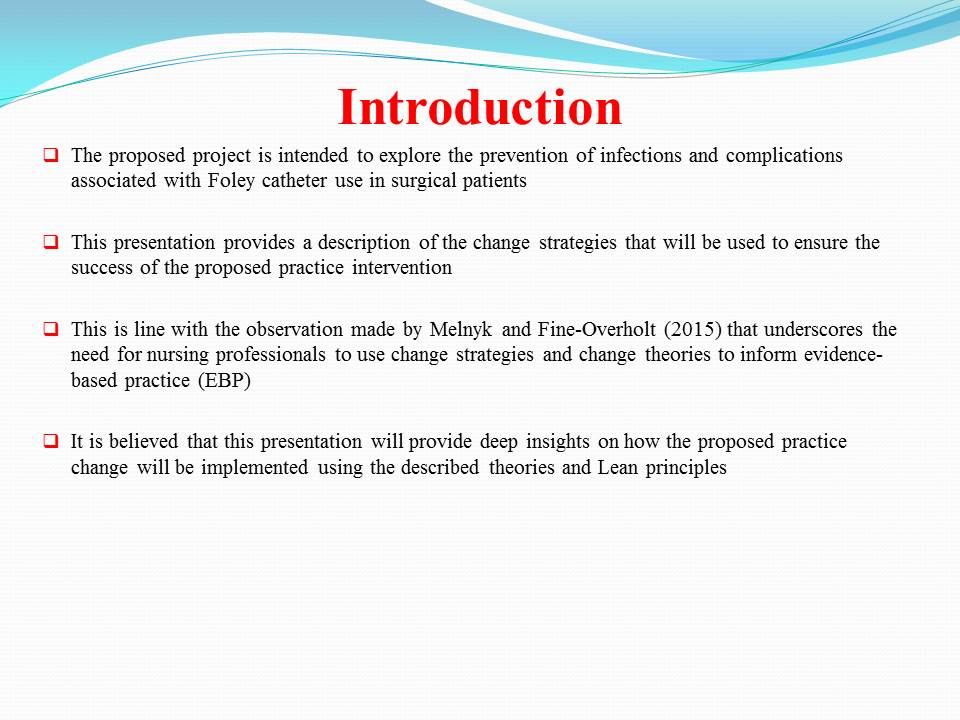
Problem Description
The problem relates to the increased number of severe complications that occur due to the usage of the Foley catheter in surgical settings.
Available scholarship demonstrates that improper usage of the Foley catheter can cause infection and further complications that, in turn, negatively affect patient safety and quality care outcomes (Fink et al., 2012).
Some of the complications associated with the use of Foley catheters include encrustation, blockage that causes painful distension of the bladder, and infection by urease-producing bacteria that colonize the catheter.
It is also evident that, “if blocked catheters are not identified and changed, serious symptomatic episodes of pyelonephritis, septicaemia, and endotoxic shock can result” (Stickler, 2014, p. 120).
Research has also found that patients using catheters in their treatment processes are more vulnerable to infections and complications since “the catheter undermines the defense systems that protect the normal bladder against infection” (Stickler, 2014, p. 120).
Nursing professionals who are ill-educated to insert Foley catheters often expose the patients to several complications, such as urethral damage, catheter-associated urinary tract infections, hematuria and false passages (Fink et al., 2012).
Improper insertion, removal, and care of Foley catheters are often associated with “high incidence of urinary tract infection, mortality rates associated with the complication of urosepsis, and costs to health services in managing complications in patients undergoing long-term catheterization” (Stickler, 2014, p. 127).
Understanding how the Foley Catheter is Prone to Infections and Complications
- “The regular mechanical filling and emptying of the normal bladder helps to ensure that any bacteria managing to contaminate the urethra or bladder are washed out from the urinary tract” (Stickler, 2014, p. 120).
- “With the Foley catheter in place, on continuous drainage into a urine collection bag, the bladder does not fill and the retention balloon ensures that a sump of residual urine is maintained below the level of the drainage eye-holes at the catheter tip” (Stickler, 2014, p. 120).
- “As urine then trickles through the catheter rather than flushing the urethra, the migration of bacteria from the contaminated skin insertion site through the urethra is not impeded” (Stickler, 2014, p. 121).
- “In the bladder, the bacterial cells invade the sump of urine which is being replenished from the kidneys” (Stickler, 2014, p. 121)
- “In this continuous culture system, rapid bacterial multiplication results in the development of enormous bacterial populations, generally of around 108 cells per mL of urine” (Stickler, 2014, p. 121).
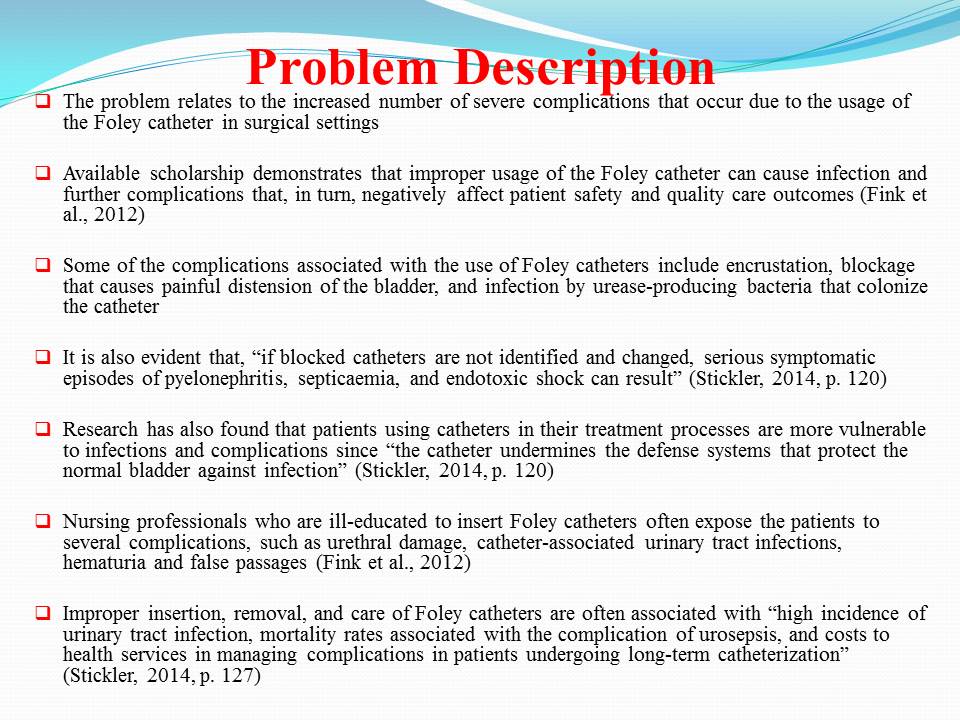
Proposed Change
Based on the identified challenges associated with the use of the Foley catheter, there is need for nursing professionals working in surgical settings to be educated and trained on the insertion, removal, and care of Foley catheters.
Owing to the fact that Kendall Regional Medical Center (KRMC) often experiences the identified challenges in its surgical patient populations, it is important to undertake a practice change that aims to provide additional education to nurses who monitor patients’ conditions with the view to empowering them with adequate knowledge on how to insert the catheter, define the best time for catheter removal, and provide antibiotic therapy to reduce the possibility of infections.
Specifically, the proposed change effort is nested in the provision of an education program that will aim to enhance the professionals’ knowledge, comfort, competence, and psychomotor skills related to the effective use of the Foley catheter in surgical settings.
Such an education program, it is felt, will significantly reduce the infections and complications arising from improper use of the Foley catheter in the hospital’s surgical settings.
The overall goal of the practice will be to prevent incidences of infection and other potentially lethal complications associated with Foley catheter use in surgical patients at KRMC.
Rationale for the Practice Change
An investigation conducted within the surgical patient population in Kendall Regional Medical Center revealed that, despite the methods that have been put in place to prevent complication s associated with the Foley catheter, patients are still exposed to infections that reinforce the prevalence of other complications and increase the mortality rate.
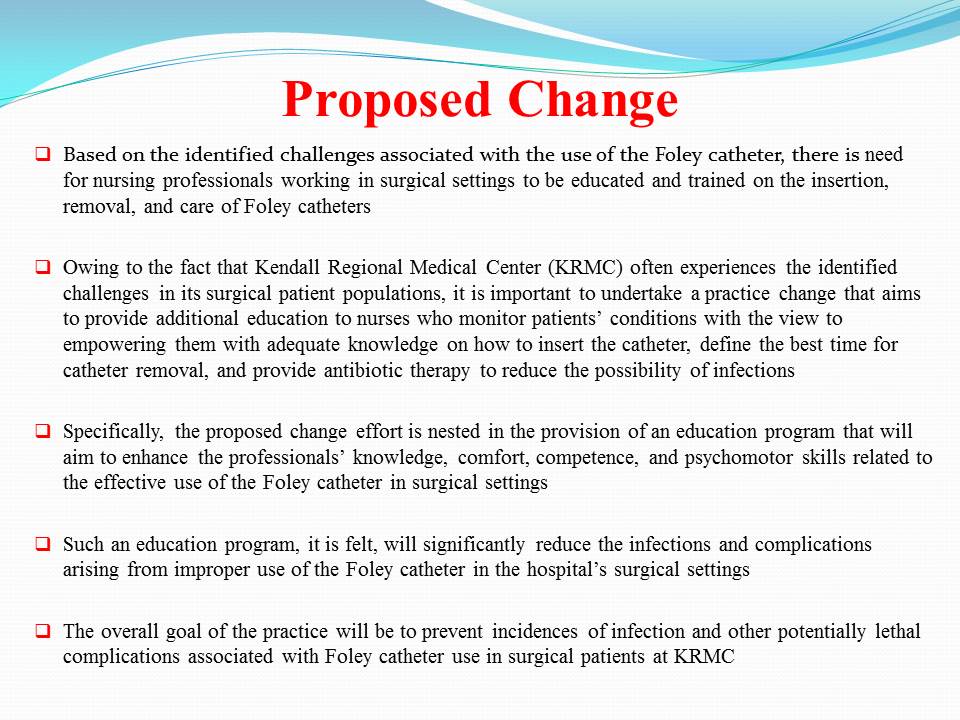
Proposed Change Theory
- The change theory that will be used to implement the proposed practice change is the Diffusion of Innovation Theory.
- Research is consistent that “the Diffusion of Innovation Theory supports the incorporation of capacity, infrastructure, facilitation, context and evidence, and provides a framework for planned organizational change necessary to implement and sustain EBP” (Schultz, 2007, p. 12).
- The proposed practice change will be implemented along the five stages of the Diffusion of Innovation Theory, discussed as follows:
The Knowledge State
In this phase, “the change agent (facilitator) must be prepared to answer questions regarding the what, why, and how of the proposed change” (Schultz, 2007, p. 12).
This phase provides the opportunity for the change agent to collect evidence and data on proper Foley catheter use, and also to share the evidence across all levels of the organization/unit.
Justification for Using the Diffusion of Innovation Theory
The selected theory is applicable in the present contexts as it ensures an enabling environment for the project facilitator and other stakeholders to diffuse evidence-based knowledge on effective Foley catheter use across the social system (surgical settings at the KRMC) with the view to enabling nurses to implement practices that would substantially minimize the prevalence of infections and associated complications associated with the improper use of the Foley catheter(Andrews, Tonkin, Lancastle, & Kirk, 2014).
Thr Persuasion Stage
In this phase, the change agent and other stakeholders in the facility will develop an opinion about the proposed intervention by asking questions that can determine the feasibility and application of the intervention.
The Decision Stage
In this phase, the proposed practice change will be pilot-tested in the surgical unit in order to monitor how the intervention is working, evaluate if the outcome change is as a result of the piloted solution or other external variables, as well as allow the facilitator and other stakeholders to make an informed decision on whether the practice change should be implemented fully or rejected.
The Implementation Stage
Once the practice change is adopted, the facilitator will use new team members and nurses to diffuse the knowledge gained from the education program across the facility with the view to enhancing uptake on the proper use of the Foley catheter.
The Confirmation Stage
The stage will provide the facilitator with the opportunity to incorporate the knowledge learnt in the education program into the standard operating procedures of the surgical unit with the view to facilitating acceptance of the change and ensuring that data are constantly collected and assessed.
Justifications for the Various Stages of the Model
The knowledge stage – to collect knowledge and evidence on how to effectively use the Foley catheter; the persuasion stage – to provide an opportunity to discuss the benefits of the proposed practice change to the unit, how it will achieve compatibility with the practice environment, and how outcomes will be observed; the decision stage – to allow the change agent to train/educate other nurses on the proposed practice change and also to collect and analyze data on how the knowledge included in the education program will reduce adverse effects of improper Foley catheter use in surgical patients; the implementation stage – to allow the facilitator to roll out the practice change across the unit; and the confirmation stage – to allow for the incorporation of the practice change into the standard operating procedures that inform the use of Foley catheter in surgical settings (Dingfelder & Mandell, 2011; Melnyk & Fine-Overholt, 2015)

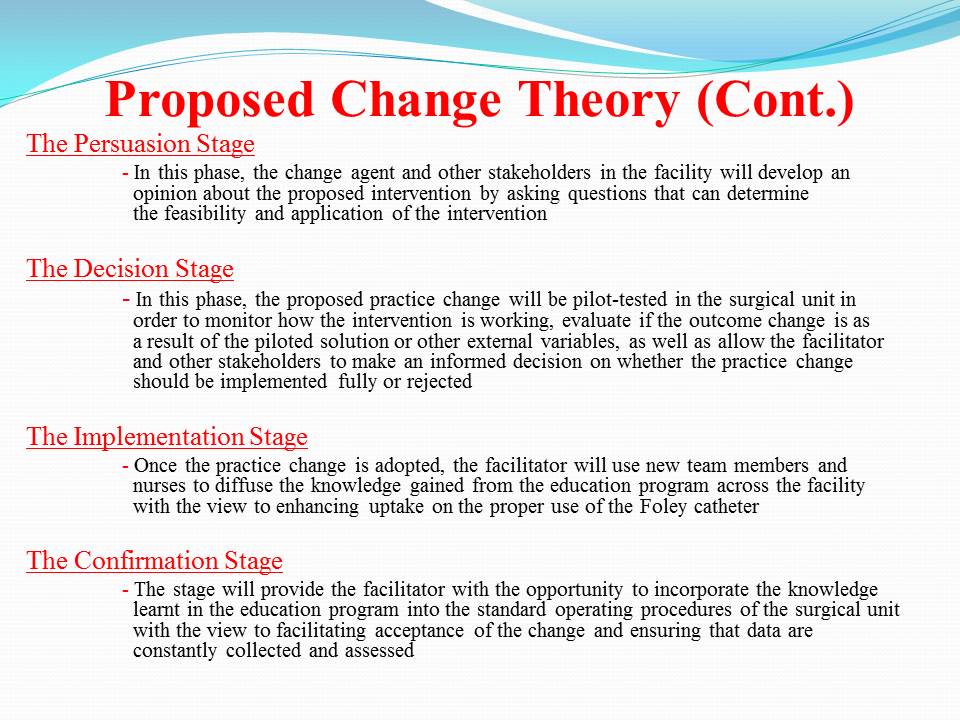
Change Strategies
Use of Best Practice Champions
“Best practice champions are nurses who promote, support, and influence the utilization of nursing best practice guidelines” (Melnyk & Fine-Overholt, 2015, p. 200).
Owing to the fact that best practice champions have the required knowledge and skills in evidence-based practice, they can be effectively used to implement and sustain evidence-based clinical guidelines on the proper use of the Foley catheter in surgical settings.
In the present context, best practice champions can be effectively used to not only build support for the proposed practice change by expressing a compelling vision and boosting organizational members, but also to move the practice change through the stages of initiation, development, and implementation according to the directions offered in the Diffusion of Innovation Theory (Shaw et al., 2012).
They can also be used to build the motor skills and confidence of nurses with the view to preventing infections and complications associated with Foley catheter use in surgical settings (Shaw et al., 2012).
It is important to align the roles of best practice champions with the goals and objectives of the proposed practice change in order to ensure that the champions are able to influence the beliefs and attitudes of other nursing professionals toward the attainment of the desired practice improvements.
Alignment in this context is described as “the synchronization of strategic goals with operations and execution tactics” (Shaw et al., 2012, p. 683).
Education and Communication
Memos and group presentations will be used to ensure nursing professionals see the need for and the logic of the proposed practice change, hence decreasing resistance.
Effective communication channels will be used to ensure that nurses have the right type of information about the proposed practice change (Melnyk & Fine-Overholt, 2015).
Education and communication is effective in addressing self-interest concerns, low tolerance to change, and frequent misunderstandings that characterize the change environment.
Participation and Involvement
All stakeholders will be encouraged to participate in the implementation of the proposed practice change to make them feel that they are part of the change effort.
It is believed that involving all the stakeholders will increase their commitment and reinforce the vision behind the proposed practice change (Melnyk & Fine-Overholt, 2015).
When all stakeholders are encouraged to participate and get involved in the implementation of the proposed practice change, it likely that issues relating to misunderstandings and mutual distrust will be solved, resulting in successful implementation of the change effort.
It is important to note that the selected change strategies can be used collaboratively to ensure that the proposed practice change will be a success; for example, the education and communication strategy can be used to reinforce stakeholder involvement and participation. The reverse is also true; that is, increasing participation and involvement will ensure that nurses get close to knowledge channels and are able to freely communicate their issues and concerns.

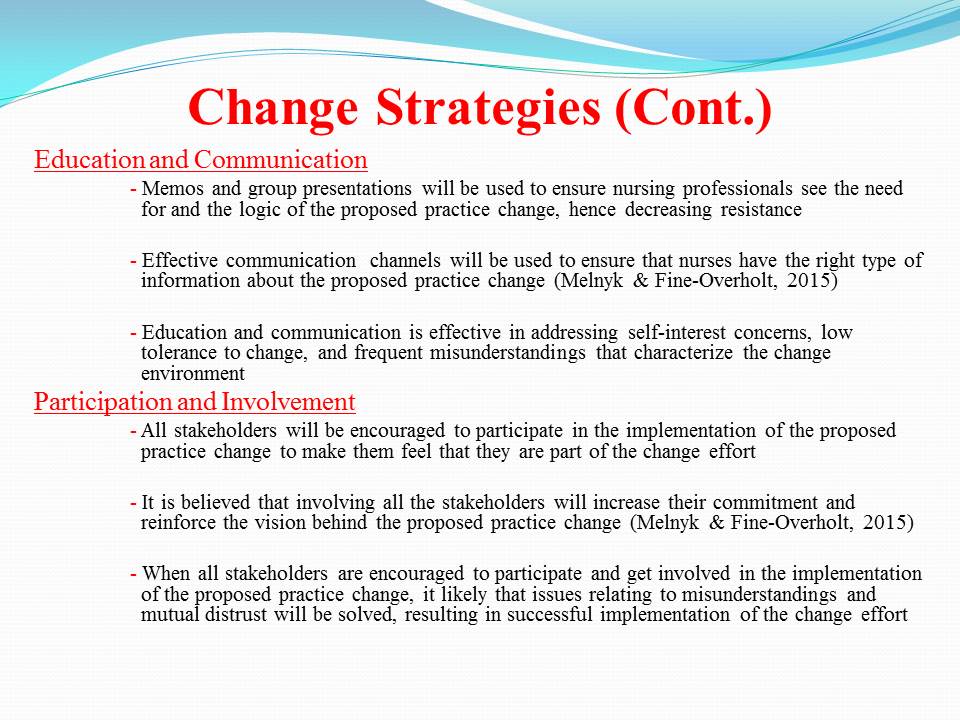
Pros and Cons of Change Strategies
Best Practice Champions
The pros of using best practice champions include:
- Capacity to promote the practice change;
- Capacity to make connections between different people and interest groups in the organization;
- Capacity to navigate the socio-political environment that characterize most health care organizations (Shaw et al., 2012).
The Cons of using best practice champions include:
- Unavailability of knowledgeable and skilled champions in actual practice settings;
- The chances of achieving success may be inhibited by a lack of shared vision or philosophy between the change agent and the best practice champions.
Education and Communication
The pros of using education and communication include:
- Capacity to address resistance issues.
- Capacity to generate a feeling of community and togetherness.
- Capacity to ensure that all stakeholders have the necessary information to make informed decisions.
An analysis of the pros and cons of the described change strategies shows that the proposed practice change has a high probability of succeeding because most of the weaknesses can be addressed through adequate planning and foresight. Most of the benefits, however, align well with the objective of using an education program to ensure that nurses develop the knowledge and skills needed to prevent infections and complications arising from Foley catheter use in surgical settings.
The cons of using education and communication include:
- Inability to work in an environment that lacks good relationships between all stakeholders;
- The strategy requires a lot of time and effort;
- The strategy involves a lot of people, hence the fear of diluting the goals and objectives of the proposed change effort.
Participation and Involvement
The pros of using participation and involvement include:
- Capacity to bring all stakeholders on board;
- Capacity to learn new ideas and concepts that could be used to improve the proposed practice change;
- Capacity to reinforce stakeholder commitment and engagement in implementing the practice change.
The cons of using participation and involvement include:
- Involving many people may lead to a poor solution if adequate care is not taken to streamline numerous ideas and suggestions coming from stakeholders;
- It may be enormously time consuming to involve all stakeholders.
These strategies are effective in dealing with the noted internal challenges to the change effort, which include nurse resistance and unpreparedness because of the interaction between various departments within the health care organization.
Overall, it is felt that the selected change strategies will be successful in achieving the project’s goal of preventing the potential complications of Foley catheter use in surgical patients so as to improve patient outcomes and reduce healthcare-associated costs.
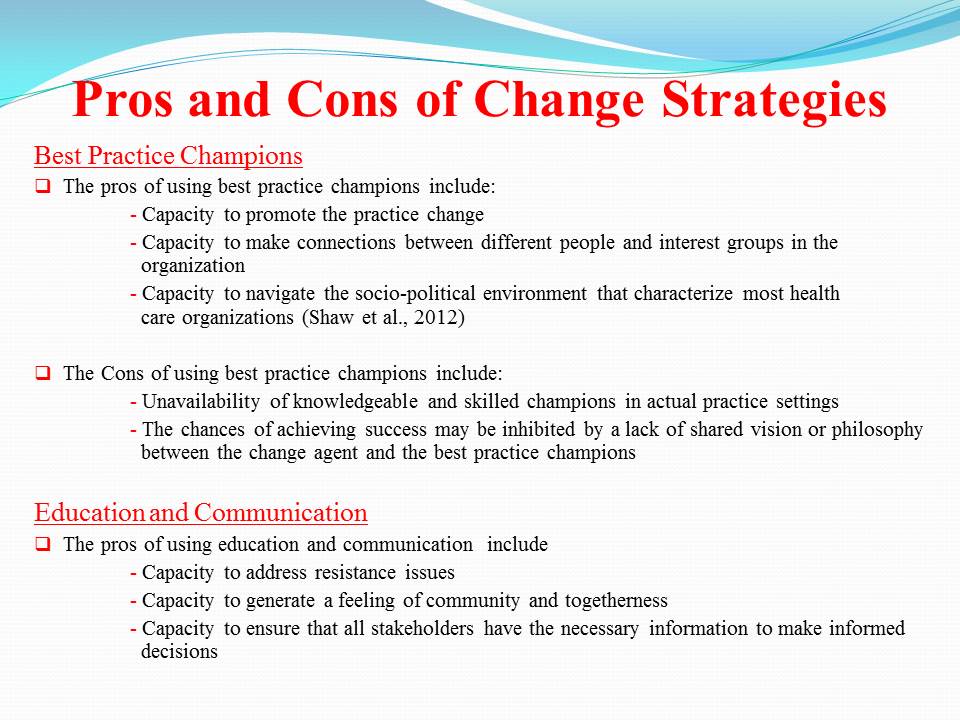
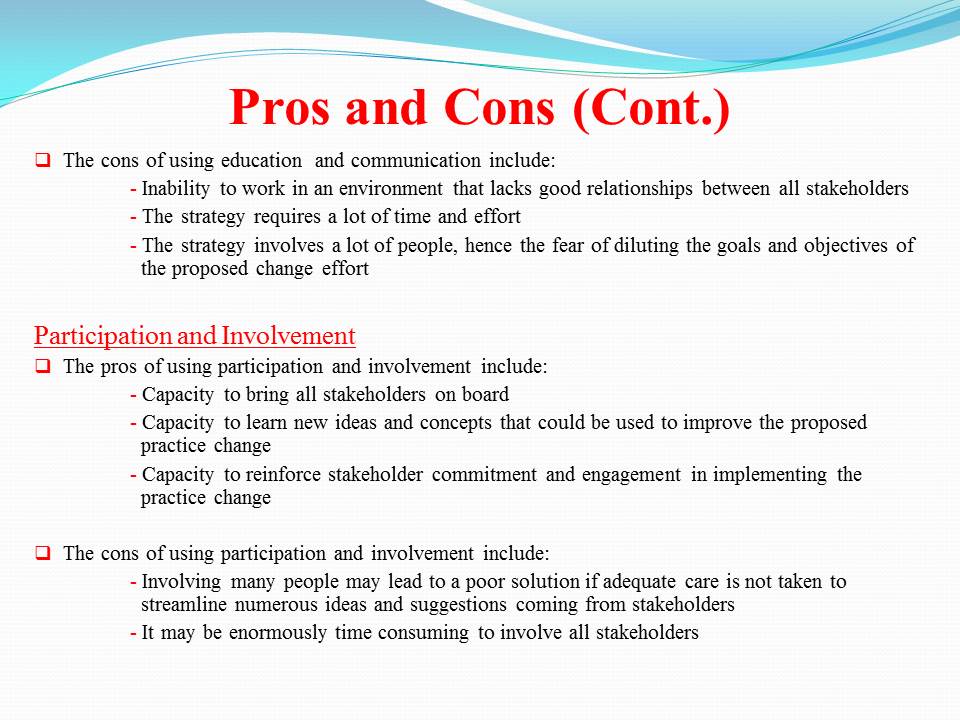
Using Teams
Available literature demonstrates that the implementation of evidence-based practices in clinical settings is a team effort (Schultz, 2007), hence the need to use a teamwork approach in implementing the proposed practice change.
As such, it will be important to form an implementation team that will be led by the implementation team facilitator with experience in using group process techniques as well as well as group dynamics to effectively manage the change effort.
Team members will be chosen from nurses who will have the most important roles in implementing the proposed practice change and those who will be directly affected by the changes.
It will be important to include change champions in the implementation team, who will be charged with the responsibility of sharing knowledge and skills with other members of the team.
This team will be used to share insights and evidence-based knowledge, reach out to other members of the organizations, engage in capacity building, and develop consensus on what needs to be done to make the implementation process a success (Melnyk & Fine-Overholt, 2015).
The team will also be used to develop clinical guidelines and evidence-based content on effective use of the Foley catheter for inclusion in the education program.
Capacity building and consensus development are extremely important in implementing a change of this nature since the expected shifts in clinical practice and management of the Foley catheter are likely to impact stakeholders from multiple departments.
Additionally, it is important to have the implementation team in place to be able to create a systematic approach with documented roles, responsibilities, and processes that will be expected to work in unison to promote the targeted changes.
A leadership team comprising the change facilitator, unit nurse leader, management representatives, human resource personnel, and representatives from the finance department will be formed to deal with issues of resource allocation, planning, and decision making.
This team will be instrumental in ensuring that the proposed practice change receives the needed attention and support from the hospital’s senior management.
Additionally, this team will be responsible for not only ensuring that resources and personnel are allocated in a timely manner, but also for dealing with any conflicts of interest that may arise during implementation.
Lastly, the leadership team will ensure the smooth running of the implementation team.
Overall, it is expected that the two teams will provide the synergies needed to successfully implement the proposed practice change, and also to ensure a coordinated approach in dealing with the issues that may arise during the implementation process (Melnyk & Fine-Overholt, 2015).
The suggested leadership team will contribute in making better and more informed decisions, focusing on the bigger vision of the organization, and ensuring that financial, human, and material resources are allocated according to the needs presented by the change initiative.
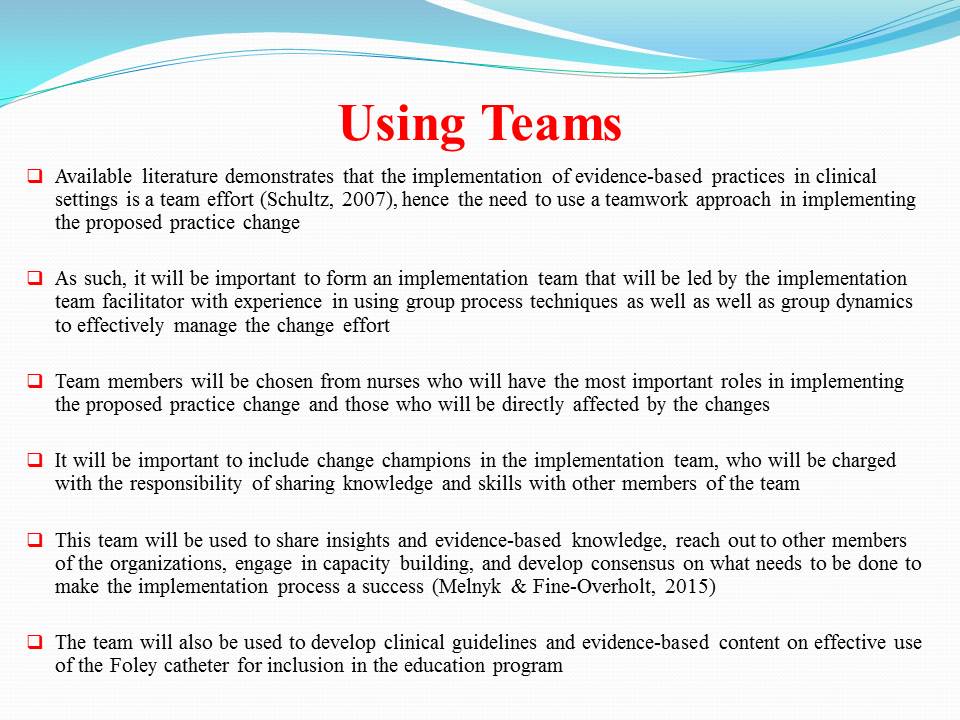
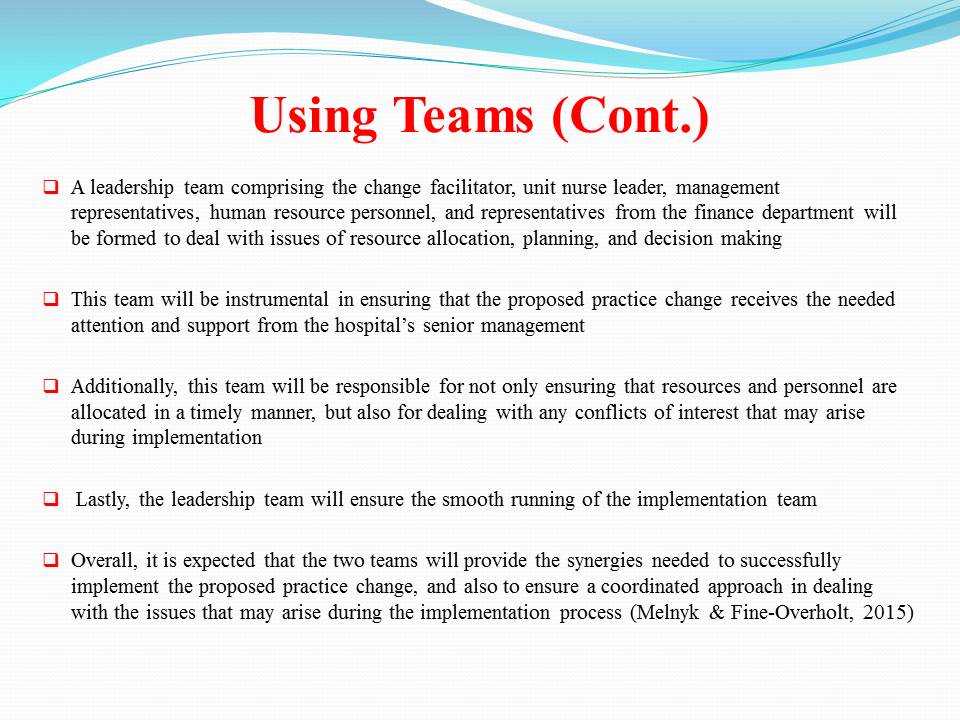
Lean Principles
Systematic Definition of the Problem
Care has been taken to systematically define the problem with the view to ensuring that the proposed practice change and the described change strategies will be effective in addressing the problem.
Setting Goals
- The main goal is to prevent infections and complications arising from Foley catheter use in surgical patients at KRMC.
- This goal has informed the development of the change strategies described in this paper.
Removing Ambiguity and Workarounds
Teams and stakeholder participation/involvement will be used to remove any role ambiguity and workarounds with the view to ensuring the success of the proposed practice change.
This principle will reduce wastage of resources and also ensure that there will be no duplication of roles during the implementation of the proposed practice change.
It is important to note that the Lean Production System aims to not only improve processes by removing activities that are non-value added, but also to undertake a root-cause analysis that purposes to identify errors and develop effective error-resolution mechanisms with the view to improving quality.
In other words, “a Lean process reflects the goal of continually reducing waste and improving work flow to efficiently produce a product or service that is perceived to be of high value to those who use it” (Schweikhart & Dembe, 2009, p. 749).
Clarifying Responsibilities
Education and communication will be used to clarify responsibilities with the view to ensure that all stakeholders perform well in their roles;
This principle will be effective in reducing conflict and ensuring that operational and process-oriented synergies are achieved during the implementation of the project;
Additionally, effective clarification of roles and job responsibilities will ensure that arising problems are rigorously tracked to their origin and dealt with in the most effective and sustainable way (Schweikhart & Dembe, 2009).
Conclusion
This presentation has provided important information relating to problem description, proposed change and the change theory that will be used to support the practice changes, as well as the change strategies that will be used to ensure successful implementation.
Overall, it can be concluded that the selected change strategies will be successful in achieving the project’s goal of preventing the potential complications of Foley catheter use in surgical patients so as to improve patient outcomes and reduce healthcare-associated costs.
It is important to note that, in healthcare settings, Lean principles can be applied to improve work processes, train employees to identify quality improvement opportunities, enhance organizational efficiency, establish broader and more customer-focused quality measurement systems, and optimize operating room scheduling (Schweikhart & Dembe, 2009).
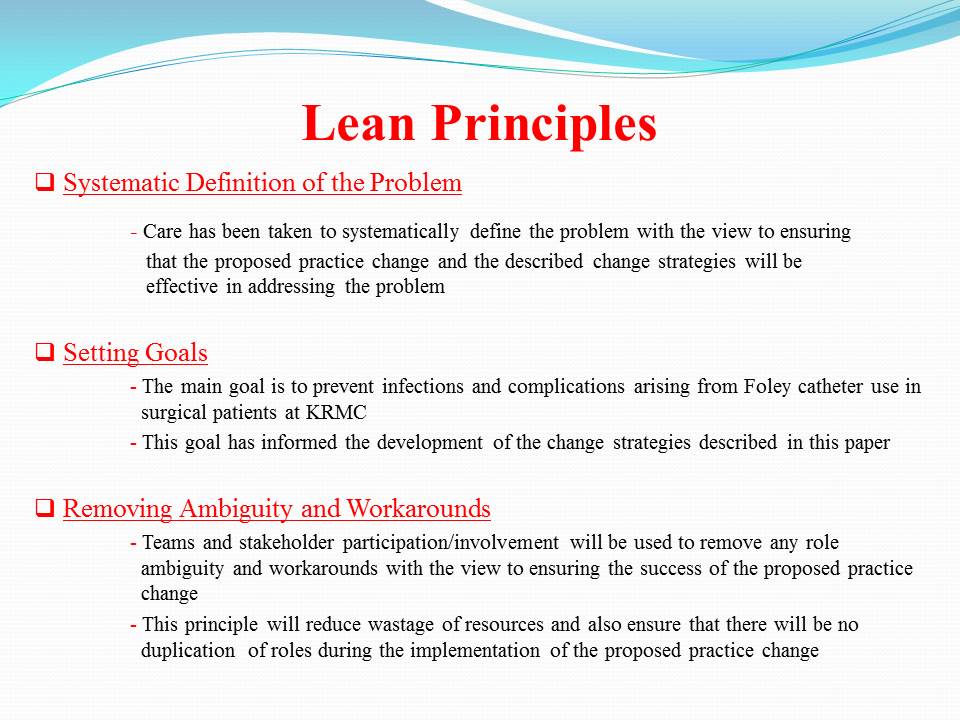
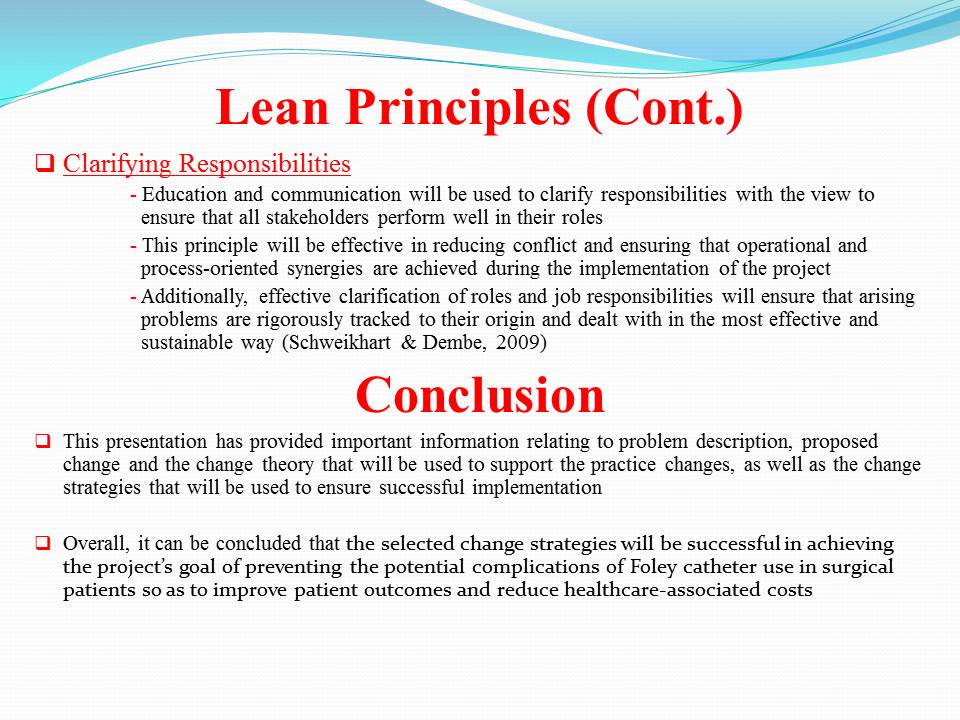
References
Andrews, V., Tonkin, E., Lancastle, D., & Kirk, M. (2014). Using the diffusion of innovations theory to understand the uptake of genetics in nursing practice: Identifying the characteristics of genetic nurse adopters. Journal of Advanced Nursing, 70, 878-893.
Dingfelder, H.E., & Mandell, D.S. (2011). Bridging the research-to-practice gap in autism intervention: An application of diffusion of innovation theory. Journal of Autism & Developmental Disorders, 41, 597-609.
Fink, R., Gilmartin, H., Richard, A., Capezuti, E., Boltz, M., & Wald, H. (2012). Indwelling urinary catheter management and catheter-associated urinary tract infection prevention practices in nurses improving care for health system elders hospitals. American Journal of Infection Control, 40, 715-720.
Melnyk, B.M., & Fine-Overholt, E. (2015). Evidence-based practice in nursing & healthcare: A guide to best practice (3rd ed.) Baltimore, MD: Lippincott Williams & Wilkins.
Schultz, A.A. (2007). Implementation: A team effort. Nursing Management, 38, 12-14. Web.
Schweikhart, S.A., & Dembe, A.E. (2009). The applicability of Lean and Six Sigma techniques to clinical and translational research. Journal of Investigative Medicine, 57, 748-755.
Shaw, E.K., Howard, J., West, D.R., Crabtree, B.F., Nease, D.E., Tutt, B., & Nutting, P.A. (2012). The role of the champion in primary care change efforts. Journal of the American Board of Family Medicine, 25, 676-685.
Stickler, D.J. (2014). Clinical complications of urinary catheters caused by crystalline biofilms: Something needs to be done. Journal of Internal Medicine, 276, 120-129.